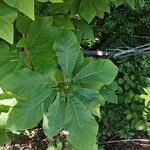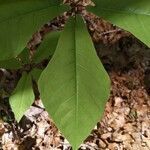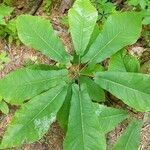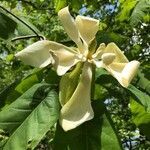Small tree to 15 m; twigs glabrous; winter terminal bud 3–5 cm, glabrous; lvs ± crowded beneath the fls, deciduous, thin, rhombic-ovate, at anthesis 1–2 dm, at maturity (2)2.5–4 dm, ca half as wide, acute to obtuse, concavely narrowed from above the middle to the base, where prolonged into short, rounded basal lobes, green and glabrous on both sides; fls white, fragrant; pet 6–9, elliptic, 7–10 × 3–4 cm, somewhat clawed; style thick, persisting as a beak on the glabrous follicle; fr-cone ellipsoid, 5–10 cm; 2n=38. Rich woods; mts. of w. Va. to e. Ky., s. to n. Ga. and Ala.; locally naturalized in Md. May, June.





